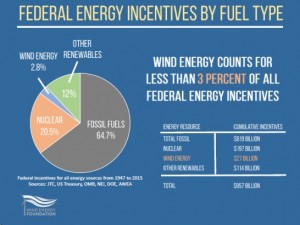Wind energy for America in Rational and Recommended
Essay by S. Tom Bond, Resident Farmer, Lewis County, WV
Wind energy is growing rapidly in many parts of America. It is the least incentivized form of energy, less than 3% of all federal energy incentives, but it is growing by leaps and bounds. A new turbine was put up every 2.4 hours during the first quarter of 2017, and 5.5 % of all electrical energy in 2016 was produced by wind. The attraction is that it has a low, stable cost. No fuel cost to go up and down, in fact no fuel cost at all! Landowners are paid for leasing rights, though. Once established, only maintenance, amortization of original cost and lease of land cost. Steady growth is expected through 2020.
By that time, it will comprise 10% of all electrical generation.
By the mid-2020s, the cost of unsubsidized onshore wind will be low enough to compete with both existing and new fossil-fueled generation in many regions of the U.S., Alex Morgan of Bloomberg of New Energy Finance, has said.
Texas is the leader with 21,000 MW of wind power, Iowa is second with about a third of that. Approximately, $245 million a year goes to local landowners for leases.
Offshore wind energy is now beginning to come online, too. The first one completed is on Block Island, off the Rhode Island coast. Previously supplied by exclusively by diesel generators, while subject to near constant wind. The new offshore wind generation makes possible cheaper electricity for Block Island which has 1000 inhabitants in the off season, but has 10,000 when the tourists come out.
This article has a map showing a dozen more projects off the Atlantic Coast which have leased Federal water and five in addition to that are in the planning stage. The article also mentions that the U. S. East Coast is one of the richest sources for wind energy in the world. One must note with some glee that it could supply precisely the area served by the two big nasty pipelines affecting West Virginia, Virginia and North Carolina, namely, the Atlantic Coast Pipeline (ACP) and the Mountain Valley Pipeline (MVP).
Onshore wind is 6 cents per kWh, completive with natural gas, but offshore is about 13 cents per kWh. Larger scale, more advanced projects will bring the cost down, a projection supported by the European experience.
Locating wind farms in the U. S. Southeast has been a tough nut to crack. The Republican legislators have fought wind “tooth and nail” by using more permitting guidelines and tougher applications. When a large wind farm was proposed, the military supported it, local communities supported it, as well as renewable energy groups. One with 104 turbines is going into Pasqotac County, NC, which will provide enough for 61,000 homes.
The Virginia Department of Environmental Quality has approved plans for a ridge top project near Roanoke in the Appalachian mountains.
Two more technical points: Taller turbines are important, because they reach up to heights where wind flow is less gusty and faster. This is particularly important where there are hills.
Second, need for storage is often cited as a weakness for wind, as it is for solar. However, up to 36% of renewables could be used without storage, by using transmission lines to take renewable energy from one area to another. Lithium ion batteries are being developed of a size that will help with this problem, too. The reader interested in this may go here, and view Section 4.1 and Table 4.1.
The future of wind is promising from several standpoints: cost, no greenhouse gas produced, and production of far more, and better, jobs than burning fossil fuels.
The big hitch is getting around the entrenched older ways of thinking to get energy: influence in legislative bodies, rapid wealth production for investors, and simple inertia in the thinking processes of the public. These must be overcome for maximum use of this new technology and the benefits it will bring.
>>> Tom Bond is a lifelong resident of West Virginia with a PhD in chemistry and years of teaching chemistry at the high school and college level.

